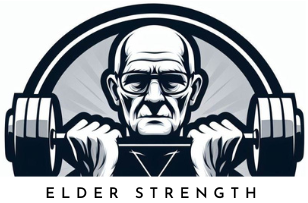In this article, you will learn about some of the best arm exercises for the elderly. As we get older we tend to lose strength and muscle mass all over our bodies.
Our legs usually get some exercise just from moving around by foot or bike, but our arms especially can easily become neglected.
Arm strength is actually not that important for overall health and functionality. This is because the strength of our prime movers is much more important for daily to day activities and overall health. This includes all our leg and core muscles.
They carry most of our muscle mass which has also beneficial metabolic functions.
Why Arm Strength Matters
The muscles of the arms are relatively small. And in modern days it’s usually enough strength if you can carry your groceries or luggage for a moderate distance. And to pick up stuff like chairs and other relatively light objects that need moving around in our homes.
Many seniors have problems even with these types of tasks if they have not exercised their arms in a long time. Or done any straining manual work with them for a while.
Strong arms are also very useful for carrying stuff. Having strong arms in addition to having an overall strong body allows you to pick up and move heavy objects safely.
The most important part of arm strength for the elderly is actually grip strength. We rarely lift anything heavy with just the muscles of the arms but any time we try to move something heavy, our grip has to be able to hold it.
There is actually a surprising correlation between grip strength and health-related life quality in seniors. You might have even measured your grip strength during a medical check.
Before we talk more about arm exercises for the elderly, let’s look at the physiology of the arms!
Muscles Of The Arm
The musculature of the arms can be divided into two distinct groups. The muscles of the forearm and the muscles of the upper arm.
Additionally, there are small muscles in your hands, but actually, all the big movers of your fingers are located in the forearm. We’ll talk more about that in a minute.
The arms are rarely used alone for lifting things except in the gym. When we use our arms in the real world there is virtually always involvement from the muscles of the shoulders, upper back, and the chest.
You see, these muscle groups are responsible for moving our upper arm relative to the shoulder joint. So anytime you lift something above you, raise your arms, push or pull something with your arms, you are using these muscles in addition to your upper arm muscles because your upper arm is moving relative to the shoulder joint.
Upper arm muscles
The upper arm muscles are responsible for extending and flexing the elbow joint. They consist of two distinct muscle groups.
The biceps
(bicep brachii) are responsible for the flexion of the elbow joint. Biceps are probably the most well-known muscle in the human body since most of us have tried flexing our biceps ever since we were young. It is the show-off muscle that guys like to flex to impress the girls.
The biceps are located on top of your upper arm and has two heads, the long and the short one. Hence, the name bicep. Bi referring to two.
The biceps are also responsible for rotating the forearm along its axis, this is called supination.
The triceps
(triceps brachii) are the antagonists of the biceps. They are responsible for extending the elbow joint. The run on the opposite side of your upper arm to the biceps. The name triceps brachii means “three-headed muscle of the arm” in Latin and refers to the three head the muscle has. Hence, the name tricep.
The three heads of the triceps are called the long head, the lateral head and the medial head.
Forearm muscles
The forearms have a couple of larger muscles like the brachioradialis that work in synergy with the bicep to flex the forearm. There are several smaller muscle groups that are responsible for moving the wrist in all directions. And flexing and extending the fingers.

This is why forearms are vital for grip strength. Any time you grip something, you are actually using the muscles of your forearm.
Exercises For The Upper Arms
Exercises for the upper arm should be divided into extension and flexion movements. Extension movements activate the biceps and extension movements activate the triceps.
You should do strength exercises on your arms at least once a week. Preferably twice. Do three sets on a weight you can do for around 8 to 15 reps. If you can do 20 reps for three times, you can usually add more weight. Once you can do three sets of 15 to 20 on the new weight, you add weight again.
These gradual increases in weight and reps will slowly build your muscles stronger and larger. Seniors and older people don’t have to worry about building “too muscular” looking arms. Clearly muscular arms require years of intense training, good genetics, and usually a young age.
Let’s look first at exercises for the biceps. Bicep curls are all you need to strengthen your biceps and they can be done at home or in the gym with dumbbells. You can learn more about them in the articles Bicep curl (for seniors) and Hand Weight Exercises For Seniors [With Tips]
For the triceps, tricep extensions are great for improving tricep strength both at home or at the gym. You can learn more about them in the article Tricep extensions (for seniors),
Exercises For The Forearms (Grip)
The best way to improve grip strength is with something called grippers. Grippers are essentially a spring that you grip and try to close. You can get them in many strengths and even adjustable strengths.
Get a gripper you can slowly close comfortably for a few repetitions. The best way to use them is slowly. You close the grip while counting five seconds for example. Hold the gripper closed for a second and open the gripper counting to five once again. This is one rep.
Aim to do 20 of these reps before switching hands (it’s wise to do one hand at a time for better focus). Once you can do 20 reps comfortably it’s time to get a harder gripper or adjust the resistance.
You can flip the gripper around for variation as well.
You can learn more about grippers and grip strength in the article Hand Grip Exercises For Seniors – Easier Than You Think
Don’t forget the shoulders, back, and chest
While doing specific strength exercises for the arms is useful, it’s important to strengthen them with multi-joint movements that target the whole upper body (or whole-body). Because the arms work in together with the muscles of the shoulders, upper back, and the chest.
Grip strength doesn’t have to be specifically trained if you do heavy enough exercises for these muscle groups. Your upper arms will get all the exercise they need from doing pulling and pushing exercises that involve the whole upper body as well.
These arm exercises are great however if you suffer from shoulder pain or mobility issues that prevent you from working your whole upper body at the same time.
You can learn more about exercises for these muscle groups in the articles Shoulder Strengthening Exercises For Seniors [4 Exercises], Back Strengthening Exercises For The Elderly [With Tips] and Push-ups (for seniors).
I’ve also written more about the importance of arm strength in the articles Flabby Arm Exercises For Seniors [Simple And Effective], Flabby Arm Exercises For Seniors [Simple And Effective] and Building Big Arms Over 50 [How To Do It Right].
Conclusion
I hope you enjoyed reading about these tips for arm exercises. If you have weak arms or grip, I hope these exercises will help you improve your arm strength.
While arm strength and muscle mass are not the most important part of overall health, it’s a vital part of your body’s functionality. Weak arms and grip can make many day-to-day chores seem harder than they need to be.
As we become older strengthening exercises help us maintain mobility and dexterity in our arms and hands. If you don’t use your hands and arms enough, you can one day realize you can’t even grip a pencil for writing.
So please take care of your arms just like you do with the rest of your body to lead a healthy and active lifestyle in older age!
If you like reading about strength training and health topics for the elderly, please subscribe to my newsletter and bookmark this site. If you have any questions or suggestions, don’t hesitate to contact me on the comments form below!
Thanks for reading and see you next time.

